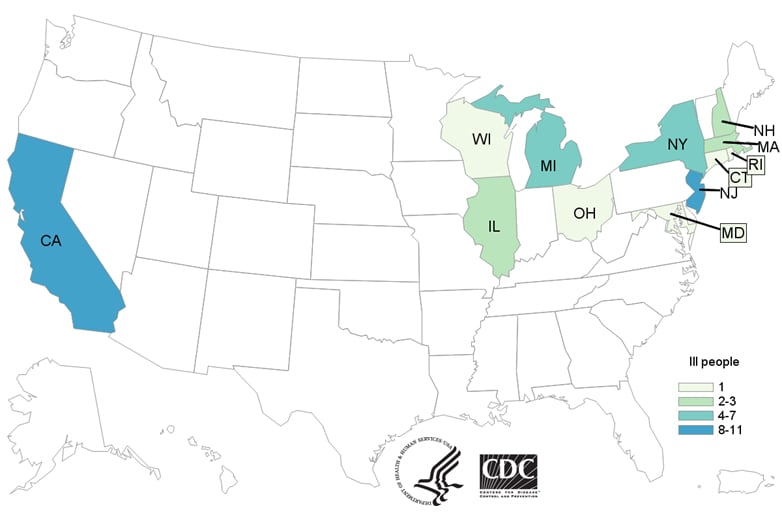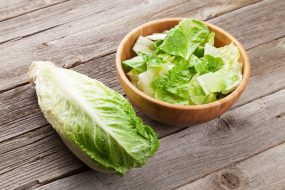Reports of 11 more Escherichia coli O157:H7 illnesses linked to the Romaine lettuce outbreak.
November 28th, 2018Based on new information, CDC is narrowing its warning to consumers. CDC is advising that U.S. consumers not eat and retailers and restaurants not serve or sell any romaine lettuce harvested from the Central Coastal growing regions of northern and central California. If you do not know where the romaine is from, do not eat it.

- Romaine lettuce products will be labeled with a harvest location by region. It may take some time before these labels are available.
- If the romaine lettuce is not labeled with a harvest growing region, do not buy, serve, sell, or eat it.
- Check bags or boxes of romaine lettuce for a label indicating where the lettuce was harvested. Romaine lettuce labeled with a harvest region outside of the Central Coastal growing regions of northern and central California (such as the desert growing region near Yuma, the California desert growing region near Imperial County and Riverside County, the state of Florida, and Mexico) is not linked to this outbreak.
- If you do not know where your romaine lettuce was harvested, do not eat it and throw it away.
- This advice includes all types or uses of romaine lettuce, such as whole heads of romaine, hearts of romaine, and bags and boxes of precut lettuce and salad mixes that contain romaine, including baby romaine, spring mix, and Caesar salad.
- If you do not know if the lettuce is romaine or whether a salad mix contains romaine, do not eat it and throw it away.
- Wash and sanitize drawers or shelves in refrigerators where romaine was stored. Follow these five steps to clean your refrigerator.
- Restaurants and retailers should check the label on bags or boxes of romaine lettuce, or ask their suppliers about the source of their romaine lettuce.
- Do not sell or serve any romaine lettuce harvested from the Central Coastal growing regions of northern and central California.
- If you do not know where your romaine lettuce was harvested, do not sell or serve it.
- Hydroponically or greenhouse-grown romaine lettuce has not been linked to this outbreak.
- Take action if you have symptoms of an E. coli infection:
- Talk to your healthcare provider.
- Write down what you ate in the week before you started to get sick.
- Report your illness to the health department.
- Assist public health investigators by answering questions about your illness.
Advice to Clinicians
- Antibiotics are not recommended for patients with E. coli O157 infections. Antibiotics are also not recommended for patients in whom E.coli O157 infection is suspected, until diagnostic testing rules out this infection.
- Some studies have shown that administering antibiotics to patients with E. coli O157 infections might increase their risk of developing hemolytic uremic syndrome (a type of kidney failure), and the benefit of antibiotic treatment has not been clearly demonstrated.
Latest Outbreak Information

At A Glance
- Reported Cases: 43
- States: 12
- Hospitalizations: 16
- Deaths: 0
- Recall: No
- Since the last update on November 20, an additional 11 ill people have been included in this investigation.
- Forty-three people infected with the outbreak strain of Shiga toxin-producing E. coli O157:H7 have been reported from 12 states.
- Illnesses started on dates ranging from October 8, 2018 to October 31, 2018.
- Sixteen people have been hospitalized, including one person who developed hemolytic uremic syndrome, a type of kidney failure. No deaths have been reported.
- The Public Health Agency of Canada has identified ill people infected with the same DNA fingerprint of E. coli O157:H7 bacteria in Canada.
- Epidemiologic and traceback evidence from the United States and Canada indicates that romaine lettuce harvested from the Central Coastal growing regions of northern and central California is a likely source of the outbreak.
- Ill people in this outbreak were infected with E. coli bacteria with the same DNA fingerprint as the E. coli strain isolated from ill people in a 2017 outbreak linked to leafy greens in the United States and to romaine lettuce in Canada. The current outbreak is not related to a spring 2018 multistate outbreak of E. coli O157:H7 infections linked to romaine lettuce.
- CDC is advising that consumers not eat any romaine lettuce harvested from the Central Coastal growing regions of northern and central California. No common grower, supplier, distributor, or brand of romaine lettuce has been identified.
- This investigation is ongoing, and CDC will provide more information as it becomes available.
Symptoms of E. coli Infection

- People usually get sick from Shiga toxin-producing E. coli (STEC) 2–8 days (average of 3–4 days) after swallowing the germ.
- Some people with a STEC infection may get a type of kidney failure called hemolytic uremic syndrome (HUS).
- E. coli infection is usually diagnosed by testing a stool sample.
- Antibiotics are not recommended for patients with suspected E. coli infections until diagnostic testing can be performed and E. coli infection is ruled out. Some studies have shown that administering antibiotics to patients with E. coli infections might increase their risk of developing HUS, and a benefit of treatment has not been clearly demonstrated.
- For more information, see Symptoms of E. coli Infection.
Investigation Details
November 26, 2018
CDC, public health and regulatory officials in several states, Canada, and the FDA are investigating a multistate outbreak of Shiga toxin-producing Escherichia coli O157:H7 (E. coli O157:H7) infections.
As of November 26, 2018, 43 people infected with the outbreak strain of E. coli O157:H7 have been reported from 12 states. A list of the states and the number of cases in each can be found on the Map of Reported Cases page.
Illnesses started on dates ranging from October 8, 2018 to October 31, 2018. Ill people range in age from 1 to 84 years, with a median age of 25. Sixty-nine percent of ill people are female. Of 38 people with information available, 16 (42%) have been hospitalized, including one person who developed hemolytic uremic syndrome, a type of kidney failure. No deaths have been reported.
Illnesses that occurred after October 31, 2018, might not yet be reported due to the time it takes between when a person becomes ill with E. coli infection and when the illness is reported. This takes an average of two to three weeks.
Investigation of the Outbreak
Epidemiologic and traceback evidence indicates that romaine lettuce from the Central Coastal growing regions of northern and central California is a likely source of this outbreak.
In interviews, ill people answered questions about the foods they ate and other exposures in the week before they became ill. Twenty-two (88%) of 25 people interviewed reported eating romaine lettuce. This percentage is significantly higher than results from a survey[PDF – 787 KB] of healthy people in which 47% reported eating romaine lettuce in the week before they were interviewed. Ill people reported eating different types of romaine lettuce in several restaurants and at home.
Preliminary traceback information from the FDA indicates that ill people in this outbreak ate romaine lettuce harvested from the Central Coastal growing regions of northern and central California. At this time, no common grower, supplier, distributor, or brand of romaine lettuce has been identified. CDC is advising that consumers not eat and restaurants and retailers not sell any romaine lettuce from the Central Coastal growing regions of northern and central California.
This investigation is ongoing, and CDC will provide more information as it becomes available.



